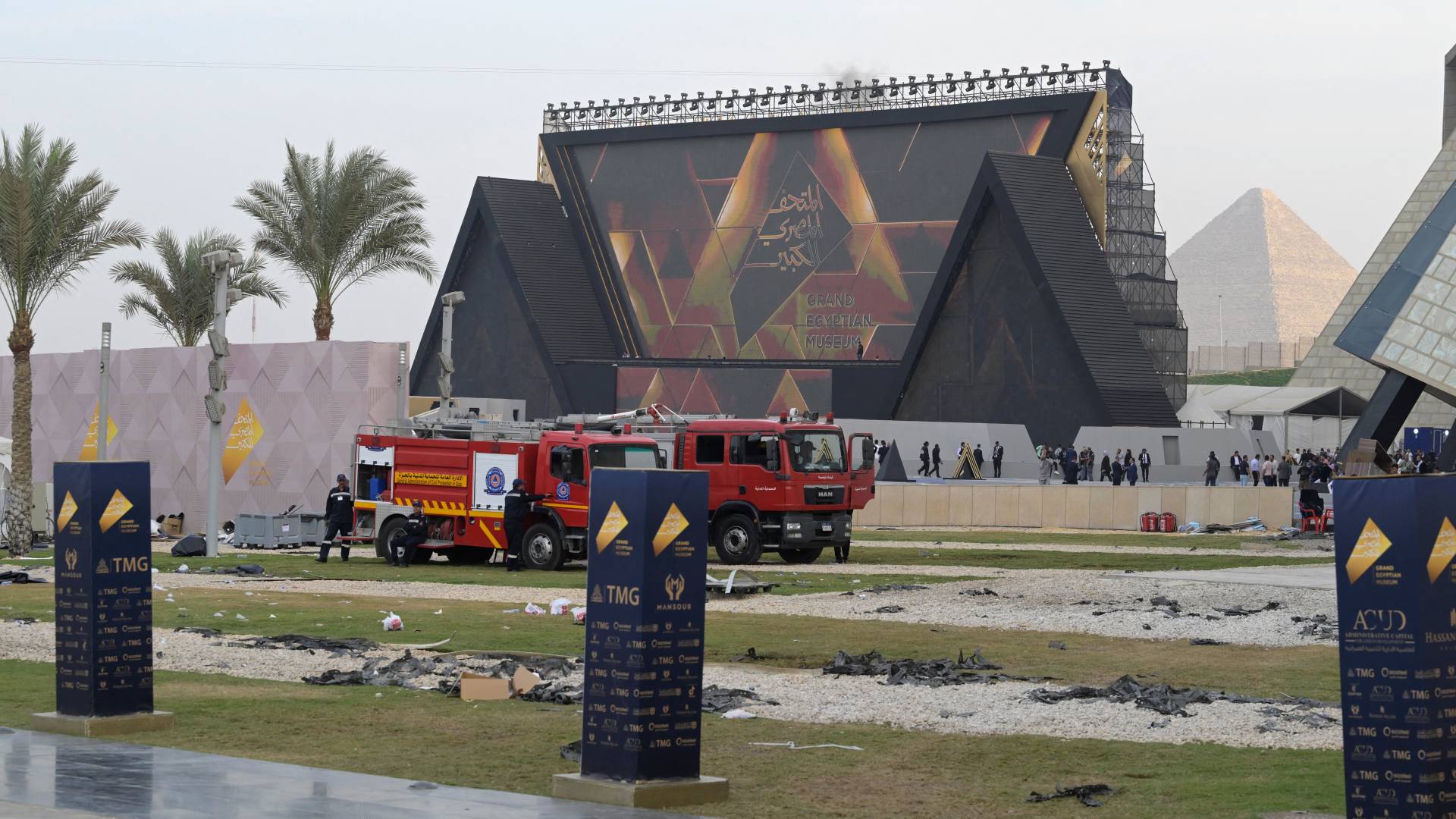The Grand Egyptian Museum (GEM), with the Great Pyramid (R), prior to its opening today in Giza, on the outskirts of the capital Cairo.
Multi-billion dollar museum aims to restore Egypt’s global presence
Note: AI technology was used to generate this article’s audio.
The Grand Egyptian Museum (GEM), chronicling the history of ancient Pharaonic civilization, officially opens in Cairo Saturday after extensive preparations and repeated delays.
The opening is marked by major celebrations aimed at re-establishing Egypt's presence on the global tourism map.
Egyptian Prime Minister Mostafa Madbouly described the museum at a news conference Saturday as a "global landmark presented by Egypt as a gift to the entire world," adding that it was "the dream that was in our imagination."
According to the Egyptian Foreign Ministry, approximately 80 official delegations are expected to attend the opening ceremony, which is scheduled to begin at 7:30 PM local time (5:30 p.m. GMT). This includes 40 delegations led by kings, princes, and heads of state and government.
In anticipation of the highly awaited event, the massive façade of the museum, which sits on a ridge overlooking the Giza Pyramids, has been illuminated in recent nights.
Two Decades in the Making
The construction of the museum, which covers nearly 500,000 square meters (about 124 acres), took more than 20 years and cost over $1 billion.
Madbouly noted that the "idea for the museum was conceived about 30 years ago... but the construction of this project went through a period of suspension due to the circumstances Egypt went through starting in 2011." He added, "I can say that the largest part of the construction took place over the last seven or eight years."
The museum's greatest treasure will be the complete collection of Pharaoh Tutankhamun, discovered in 1922 in the Valley of the Kings in Upper Egypt. This collection, which includes about 5,000 funerary objects, was previously scattered among several museums in Egypt, touring the world, or held in storage. It will now be united in one hall within the GEM.
In total, the Grand Egyptian Museum houses more than 100,000 artifacts, half of which will be on display, making it the largest collection globally dedicated to a single civilization, which saw 30 dynasties over 5,000 years.
Visitors are welcomed into a spacious atrium centered around a colossal, 83-ton granite statue of Pharaoh Ramses II, who ruled Egypt for more than 3,000 years. The statue stands 11 meters (36 feet) tall.
Unlike the century-old, cramped museum in the center of the capital, the GEM features vast halls, precise lighting, virtual reality exhibits, and a children's museum within its sandstone-colored walls. Through a glass window, archaeology enthusiasts will be able to watch work being done inside the restoration laboratory on a 4,500-year-old solar boat, found buried near the Pyramid of Cheops.
Delays and Regional Headwinds
The opening of the Grand Egyptian Museum was repeatedly postponed due to various reasons, including the "Arab Spring" protests and the COVID-19 pandemic. After authorities set a date of July 3, 2025, for the opening, they decided to postpone it again due to regional tensions at the time, particularly the war in Gaza and the aftermath of the Iran-‘Israel’ conflict.
Observers caution that the long-term success of the GEM as a global tourist destination depends on stable tourism and solid infrastructure.
Egyptian archaeologist Hussein Bassir said the museum's future relies on "regular maintenance to preserve the building and its treasures." He told AFP,
"If the current momentum is not maintained, the museum may quickly lose its attractiveness and the number of visitors may drop."
Egypt's tourism sector, a vital source of foreign currency and jobs, has been repeatedly disrupted over the past decade and a half by the 2011 uprising, waves of unrest, and subsequent terrorist attacks.
Transforming the Giza Plateau
Elhamy El Zayat, former head of the Egyptian Tourism Federation, told AFP the museum is part of a larger plan to transform the entire Giza Plateau. He noted that "Egypt has created a completely new cultural and tourist zone" on the plateau, with a nearby airport and enhanced visitor facilities at the pyramids.
Roads leading to the plateau have been refurbished, a digital ticketing system has been introduced, and air-conditioned electric buses now operate near the pyramids.
In recent years, tourism has shown signs of recovery. Egypt welcomed 15 million visitors in the first nine months of the year, a 21% increase compared to the same period last year, with revenues reaching $12.5 billion (a 14.7% increase), according to official figures.
Tourism Minister Sherif Fathi told reporters that "5,000 to 6,000 visitors are currently visiting the museum," adding, "We expect this to reach 15,000 [visitors] daily."
He added that the government is working to finalize a comprehensive development plan for the northeastern area of Cairo, from the new Sphinx International Airport to the Saqqara pyramids, including hotels, restaurants, and commercial centers.




